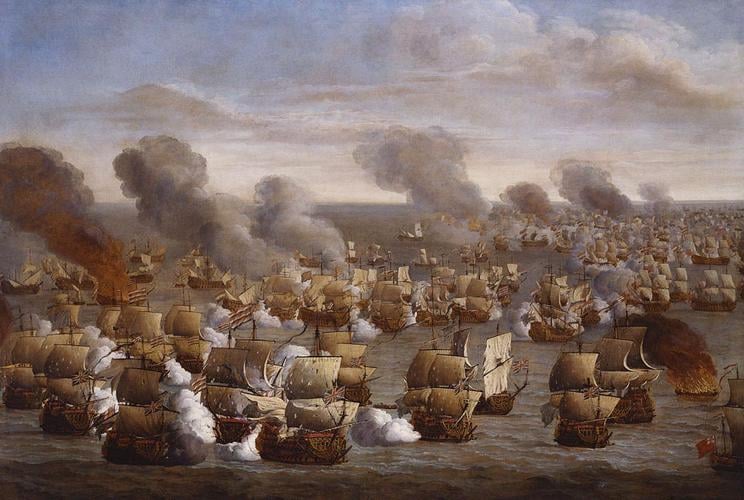-
1 of 253523 objects
The Battle of the Texel (Kijkduin), 21 August 1673 Signed and dated 1682
Oil on canvas | 126.0 x 182.5 cm (support, canvas/panel/stretcher external) | RCIN 405306

Willem van de Velde the Elder (1611-93)
The Battle of the Texel (Kijkuin), 21 August 1673 Signed and dated 1682
-
Upon the Restoration in 1660 Charles II appointed his brother, James (Duke of York and later James II), to the position of Lord High Admiral, in which capacity he commanded the Royal Navy during the Second (1665-7) and Third (1672-4) Anglo-Dutch Wars (the First (1652-4) took place in Cromwell’s time). In 1675 he commissioned from the recently-arrived Dutch artists (Van de Veldes, father and son) a set of large canvases depicting episodes in these two conflicts and the ongoing struggle against the Barbary Corsairs. Previous commissions of this type had been for tapestries, like the famous Armada set hanging at this date in the House of Lords. This is one of several of the paintings in this series which have the character of tapestries, with high view points and a crowding of incidents (as opposed to the sea-level, atmospheric view of their other oil paintings).
The final show-down of the Third (and final) Anglo-Dutch War on 21 August 1673 resulted in the failure of the English and French allies to dislodge the Dutch fleet from their position prior to invading from the sea. Texel is one of the string of islands guarding the entrance to Dutch waters from the North Sea. Though the battle itself was a stalemate the consequence was the salvation of the Dutch homeland, for which the Dutch admirals, Michiel de Ruyter, in command, and Cornelis Tromp, are justly celebrated. The Treaty of Westminster was concluded on 9 February 1674.
That James Duke of York should commission (in 1682) a depiction of the enemy’s finest hour is partly explained by the fact that in 1677 his daughter, Mary, married his opposite number, the Admiral-General of the Dutch fleet, William III of Orange. The peace between the two countries (if not these individuals) was further cemented in 1688 when William III of Orange deposed his father-in-law during the Glorious Revolution to become the joint ‘Stadholder King’ of Britain and the United Provinces.
A view of the Battle, with "The Prince" in the left foreground, her mainmast having just fallen; ships of the squadron are in the right background; the "Royal Sovereign" is on the extreme right; beyond is the French squadron.
Inscribed lower right: 'Velde f. 1682'Provenance
Commissioned by James II when Duke of York
-
Medium and techniques
Oil on canvas
Measurements
126.0 x 182.5 cm (support, canvas/panel/stretcher external)
142.6 x 198.8 x 5.2 cm (frame, external)
Category
Object type(s)
Other number(s)
Alternative title(s)
The Battle of the Texel (Kijkuin), 21 August 1673